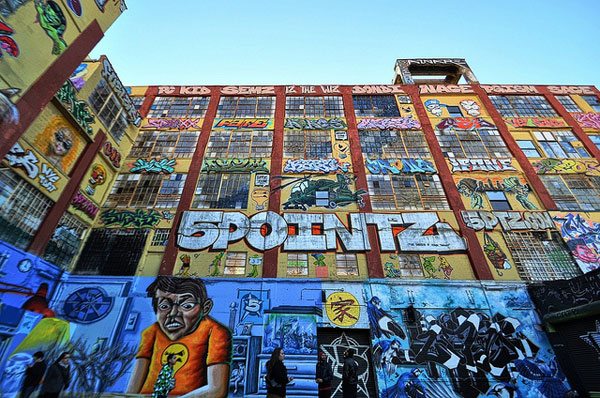
February 13, 2018; Washington Post
5Pointz (also known as 5Pointz: The Institute of Higher Burnin’) was an epicenter of the graffiti scene that attracted many of the world’s most prominent aerosol artists. 5Pointz consisted of twelve factory buildings in Long Island City, Queens, New York City. Built in 1892, the buildings were one, three, or five stories high, originally housing the Neptune Meter factory. The interconnected buildings housed the Crane Street Studios, in which some 200 artists paid below-market rents for studio space.
Jerry Wolkoff bought the property in the early 1970s and leased the space to various companies. By the 1990s, Wolkoff began leasing space to artists with permission to graffiti over the exterior walls. Jonathan Cohen coined the moniker “5Pointz” as a reference to their art bringing together NYC’s five boroughs: “Wolkoff gave Cohen and hundreds of other artists free rein to paint whatever they pleased, with only three exceptions: no religion, politics or sex. Artists from all backgrounds poured in from all over the world.” Millions of people appreciated the renowned cultural landmark from the elevated 7-train that passed nearby. The mural art served as a destination for tourists, and as a backdrop for music videos, movies, weddings, and concerts.
The troubles began in 2013, when Wolkoff unilaterally decided to demolish 5Pointz and replace it with a condominium complex. His announcement resulted in a lawsuit filed by the 5Pointz artists. Hyperallergic chronicles the years-long battle here.
When the artists got wind of the landlord’s plans to replace the warehouses with high-rise luxury condos, they began a campaign to try to save 5Pointz. Cohen filed an application with the City Landmark Preservation Commission to preserve the site but was rejected because the artistic work was too recent. He also tried to raise money to buy the property, but its value soon skyrocketed to more than $200 million.
The 5Pointz buildings were demolished completely by 2014, but not before the wall art were unceremoniously whitewashed. Construction of two residential towers (48 and 41 stories) began in 2015 and continues.
The protesting artists filed a federal lawsuit against Wolkoff, stating that the destruction of the buildings without notice violated the Visual Artists Rights Act. This trial would decide whether graffiti is federally protected.
Sign up for our free newsletters
Subscribe to NPQ's newsletters to have our top stories delivered directly to your inbox.
By signing up, you agree to our privacy policy and terms of use, and to receive messages from NPQ and our partners.
In November 2017, a jury recommended that the judge rule that the destruction of the graffiti was in fact illegal. In a dramatic conclusion to this landmark case, the judge just decided in favor of the 21 artists, awarding them maximum damages of $6.7 million ($150,000 for each of the 45 works destroyed), saying Wolkoff “‘willfully’ ruined the artwork and showed no remorse for his ’recalcitrant behavior.’”
This battle between the rights of New York City’s two most prominent forces, art and real estate, set a decisive precedent for the protection of graffiti art across the country. This decision establishes that the ruined murals have enough artistic stature to merit being protected.
The judge’s ruling came after a milestone three-week trial in November in U.S. District Court in Brooklyn. The case marked the first time a court has been asked to determine whether graffiti—with its ephemeral nature—should be considered art protected under federal law, according to a court opinion.
The judge asserted that some of the destroyed images “reflect striking technical and artistic mastery and vision worthy of display in prominent museums if not on the walls of 5Pointz.”
“The shame of it all is that since 5Pointz was a prominent tourist attraction the public would undoubtedly have thronged to say its goodbyes during those 10 months and gaze at the formidable works of aerosol art for the last time,” Block concluded. “It would have been a wonderful tribute for the artists that they richly deserved.”
Accustomed to being displaced by the interests of real estate developers, evocative, outsider street artists are now having a dialogue with history.—Jim Schaffer













